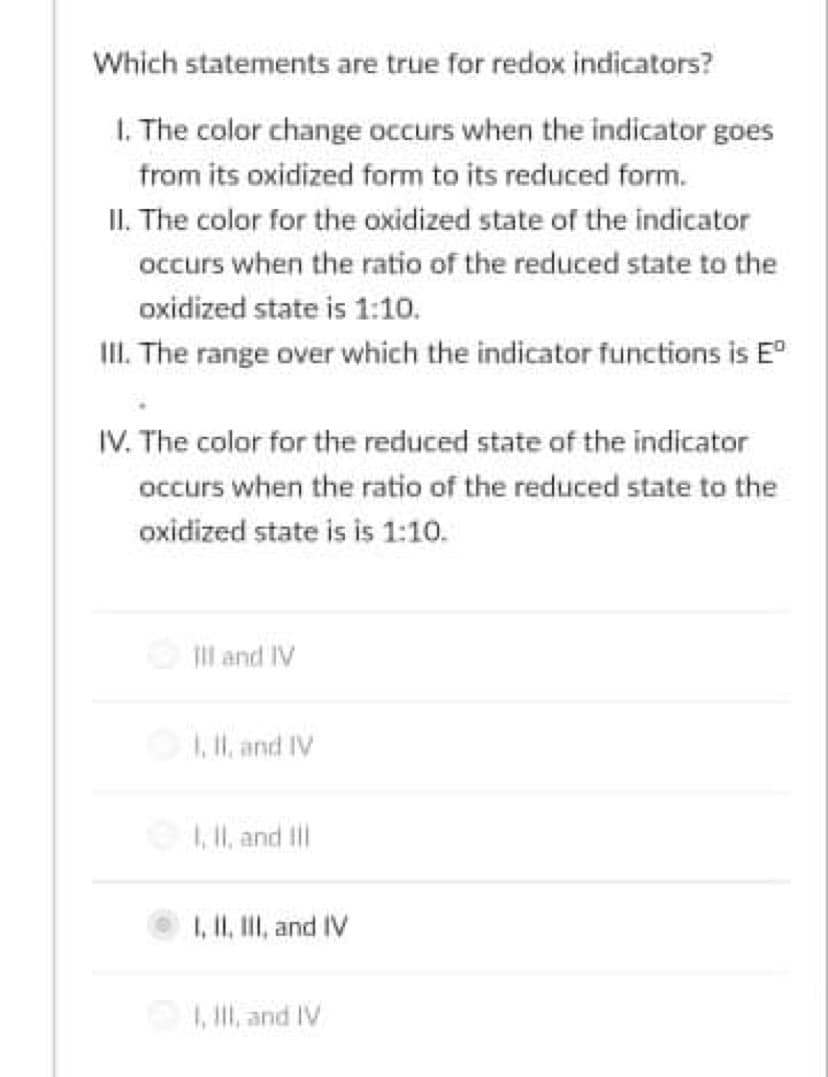Which of the statements below are true for the titration of Fe2* with standard Cet? I. The indicator electrode potential before the addition of Cet solution is calculated using the Fe+ half-reaction after calculating the equilibrium
Which of the statements below are true for the titration of Fe2* with standard Cet? I. The indicator electrode potential before the addition of Cet solution is calculated using the Fe+ half-reaction after calculating the equilibrium
Chapter10: Potentiometry And Redox Titrations
Section: Chapter Questions
Problem 3P
Related questions
Question
![Which of the statements below are true for the
titration of Fe2t with standard Ce?
I. The indicator electrode potential before the
addition of Cet solution is calculated using the
Fea+ half-reaction after calculating the equilibrium
concentrations of Fe3+ and Fe2+ in solution.
II. Before the equivalence point, the indicator
electrode potential is calculated using the Fe3+
half-reaction because only [Fe3] and [Fe2*] are
known.
III. At the equivalence point, the indicator potential is
the average of E" for Fet and Cet.
IV. After the equivalence point, the indicator
electrode potential is calculated using the Ce**
half-reaction because only [Ce"] and [Ce2*] are
known.
1, II, II, and IV
I, II, and IV
II, III, and IV
1, I1. and IV](/v2/_next/image?url=https%3A%2F%2Fcontent.bartleby.com%2Fqna-images%2Fquestion%2F386f8283-9ac2-474e-b6c8-1cd7a8987d20%2Fda64bac4-b3b5-4600-90ae-745cf73c1175%2Fy1i4sck_processed.jpeg&w=3840&q=75)
Transcribed Image Text:Which of the statements below are true for the
titration of Fe2t with standard Ce?
I. The indicator electrode potential before the
addition of Cet solution is calculated using the
Fea+ half-reaction after calculating the equilibrium
concentrations of Fe3+ and Fe2+ in solution.
II. Before the equivalence point, the indicator
electrode potential is calculated using the Fe3+
half-reaction because only [Fe3] and [Fe2*] are
known.
III. At the equivalence point, the indicator potential is
the average of E" for Fet and Cet.
IV. After the equivalence point, the indicator
electrode potential is calculated using the Ce**
half-reaction because only [Ce"] and [Ce2*] are
known.
1, II, II, and IV
I, II, and IV
II, III, and IV
1, I1. and IV

Transcribed Image Text:Which statements are true for redox indicators?
1. The color change occurs when the indicator goes
from its oxidized form to its reduced form.
II. The color for the oxidized state of the indicator
occurs when the ratio of the reduced state to the
oxidized state is 1:10.
II. The range over which the indicator functions is E
IV. The color for the reduced state of the indicator
occurs when the ratio of the reduced state to the
oxidized state is is 1:10.
Il and IV
1, I, and IV
1, Il, and tll
I, II, II, and IV
1, Ill, and IV
Expert Solution
This question has been solved!
Explore an expertly crafted, step-by-step solution for a thorough understanding of key concepts.
Step by step
Solved in 2 steps with 1 images

Knowledge Booster
Learn more about
Need a deep-dive on the concept behind this application? Look no further. Learn more about this topic, chemistry and related others by exploring similar questions and additional content below.Recommended textbooks for you


Chemistry: An Atoms First Approach
Chemistry
ISBN:
9781305079243
Author:
Steven S. Zumdahl, Susan A. Zumdahl
Publisher:
Cengage Learning

Chemistry
Chemistry
ISBN:
9781305957404
Author:
Steven S. Zumdahl, Susan A. Zumdahl, Donald J. DeCoste
Publisher:
Cengage Learning


Chemistry: An Atoms First Approach
Chemistry
ISBN:
9781305079243
Author:
Steven S. Zumdahl, Susan A. Zumdahl
Publisher:
Cengage Learning

Chemistry
Chemistry
ISBN:
9781305957404
Author:
Steven S. Zumdahl, Susan A. Zumdahl, Donald J. DeCoste
Publisher:
Cengage Learning


Principles of Instrumental Analysis
Chemistry
ISBN:
9781305577213
Author:
Douglas A. Skoog, F. James Holler, Stanley R. Crouch
Publisher:
Cengage Learning
